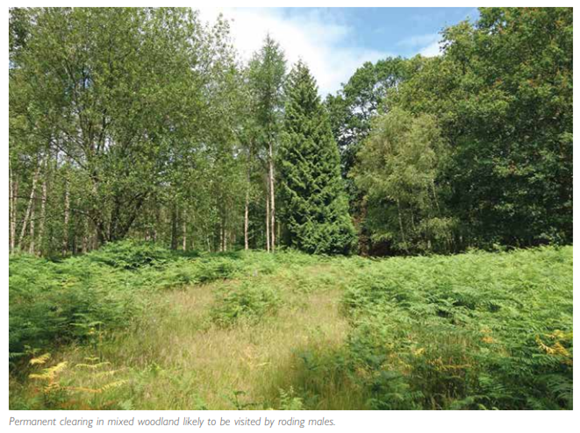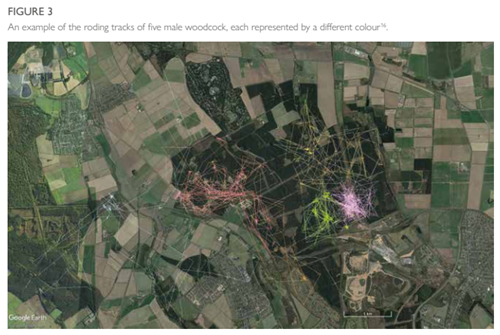We have recently published Conserving Our Woodcock, a new guide which turns 50 years of GWCT woodcock research into practical guidance on how to provide the varied habitat woodcock require. This blog is taken from the guide, which you can download in full here.

Researching habitat for breeding woodcock
We cannot support our resident woodcock without a clear understanding of what constitutes good breeding habitat. There are certain longunderstood themes – woodcock are associated with woodland; they eat earthworms so need soft, healthy soil; are secretive and therefore likely to be averse to disturbance; and as a ground-nesting species, are vulnerable to both mammal and bird predators. However, these general points are not enough to guide us as to specifically how we might help woodcock. Several of the GWCT’s research projects have helped add detail to the knowledge we need to provide areas where breeding woodcock can thrive.
Early studies using radio tags helped us better understand woodcocks’ habitat usage and their movements in the breeding season. These showed for the first time that all adult woodcock alter their feeding behaviour during the breeding season compared to their winter routines, regardless of whether the individual is involved with a nest or brood.
In winter, adult woodcock feed on open pastures at night but this becomes less common in the breeding season, when they switch to feeding under cover in woodland during the day. This is probably because in the summer open land becomes drier and earthworms become harder to find, crops and ungrazed meadows become too tall, and there are fewer hours of darkness to safely feed in the open.
When feeding in woodland, woodcock tend to use areas where trees are relatively small and close together, with a layer of shrubs or herbaceous plants dense enough to provide cover but through which they can still easily travel. These are often areas of young sycamore or birch with an field layer of dog’s mercury or bramble, but birds avoid areas that are predominantly beech or pine.
However, when choosing a nesting site (rather than a feeding site in the nesting season) woodcock use woodland areas with more open ground vegetation, which still have overhead cover from trees. This use of different nesting and foraging habitat nearby to each other suggested that woodcock need a mix of different types of habitat to thrive, a finding that was confirmed by later studies.
Combined with the need for open roding areas and winter-feeding pastures or fields, this demonstrates that the landscape as a whole needs to be suitable for an area to fulfil the varying needs of woodcock throughout their life cycle.
National survey findings for woodcock habitat
More habitat studies followed, using the information that was collected during the 2003 national survey. When woodcock counts were carried out for that survey, information was also collected about the habitat surrounding the survey sites, so we analysed these two streams of data together to help understand what sort of areas woodcock were choosing to breed in.
This recent retraction to more heavily-wooded areas might be connected to the woodland’s diversity, its management or the fact that smaller woods are more likely to dry out. We found woodcock numbers were generally higher in woods that included at least some broadleaved trees, but that this depended on the tree species in question. Conifer-dominated woodlands were used, but this was more likely if conifers were interspersed with broadleaved stands.

Beech woods rarely support woodcock, possibly because their tough leaves are not palatable to earthworms and they grow in fairly dry areas, so the soil is not ideal for woodcock feeding. Birch woods are much more likely to host woodcock, with wetter soil more amenable to probing bills, leaves breaking down quickly and the soil supporting earthworms and other invertebrates.
Woodcock also tend to be found in greater numbers further from built-up areas that are presumably associated with more human activity and therefore disturbance. The ideal areas seem to be far from human settlement, in a landscape with plenty of varied, connected woodland patches.
Roding counts
The roding display flight is a fascinating aspect of woodcock breeding behaviour, and the development of the GPS logger allowed us to study roding behaviour in more detail. Firstly, GWCT scientists developed a more effective method of catching woodcock at dusk which incorporated using a model decoy woodcock on the ground and playing an audio recording of part of the roding call, followed by a chasing call that is used by male woodcock in confrontations. This combination lured roding males down into mist-nets and meant that the catch rate was nine times higher than when attempting to catch without the decoy and calls.
Using this method, 45 male woodcock were tagged across three woodland sites in Nottinghamshire, over three years. Thirty-seven of these tags were recovered so their data could be used. The results shed new light on roding ranges and habitats. Woodcock roding ranges were larger than had previously been thought, although there was wide variation between different birds. Some ranges were much larger, some were smaller, some connected different areas of woodland, some were more focused (FIGURE 3). These differences may be because of a hierarchical system where more dominant males are able to access the best areas with the most females.

Despite this variability, and the fact that this technique is different to those used previously so the results may not be comparable, these findings still suggest that roding ranges may be much larger. The previous study in this area with work carried out using radio transmitters in the 1970s suggested the average total roding ground, for males radiotracked for 100 days, was 88ha in size. In this study, more than half of the males studied displayed over larger areas than that in a single night.
As well as this, the routes we recorded didn’t adhere to the traditionally held view of roding as a series of repeated circuits. Instead, the paths taken were often far more varied, but the areas covered by each individual over consecutive nights were broadly similar.
In terms of the habitat that male woodcock choose, it was traditionally thought that roding occurred over rides and clearings within woodland. The results of our tracking confirmed this view – and identified a particularly strong association with permanent open areas such as rides andglades, rather than temporary ones such as clearfelled stands.